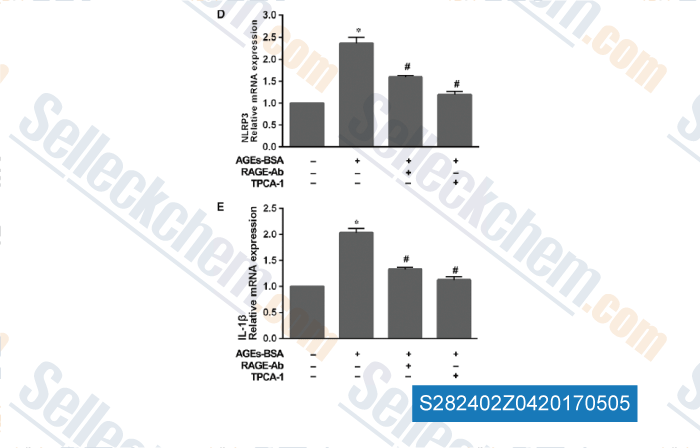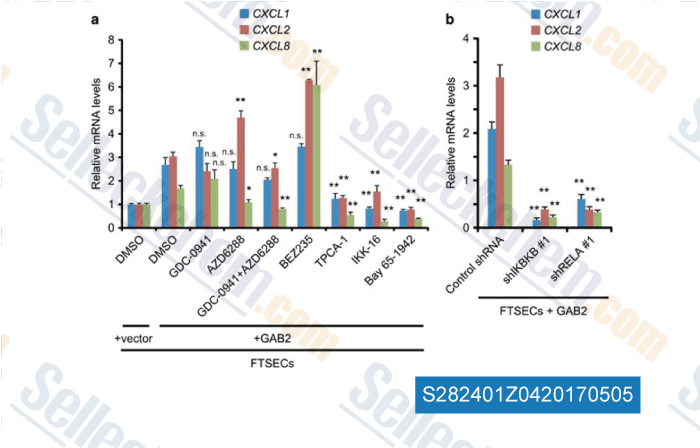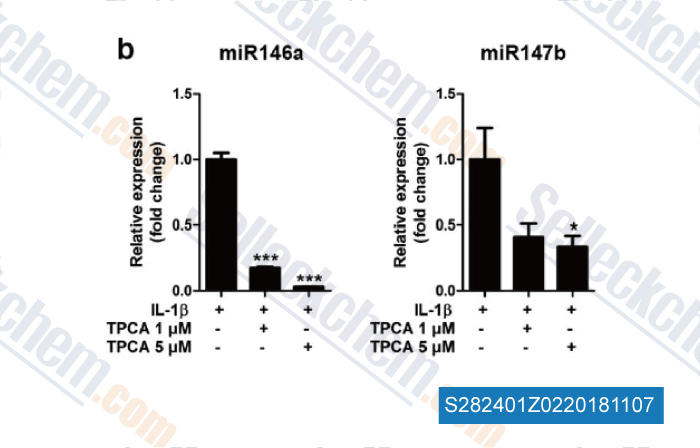|
How to Cite 1. For In-Text Citation (Materials & Methods): 2. For Key Resources Table: |
||
|
Toll Free: (877) 796-6397 -- USA and Canada only -- |
Fax: +1-832-582-8590 Orders: +1-832-582-8158 |
Tech Support: +1-832-582-8158 Ext:3 Please provide your Order Number in the email. We strive to reply to |
Technical Data
| Formula | C12H10FN3O2S |
||||||||||||||
| Molecular Weight | 279.29 | CAS No. | 507475-17-4 | ||||||||||||
| Solubility (25°C)* | In vitro | DMSO | 56 mg/mL (200.5 mM) | ||||||||||||
| Water | Insoluble | ||||||||||||||
| Ethanol | Insoluble | ||||||||||||||
| In vivo (Add solvents to the product individually and in order) |
|
||||||||||||||
|
* <1 mg/ml means slightly soluble or insoluble. * Please note that Selleck tests the solubility of all compounds in-house, and the actual solubility may differ slightly from published values. This is normal and is due to slight batch-to-batch variations. * Room temperature shipping (Stability testing shows this product can be shipped without any cooling measures.) |
|||||||||||||||
Preparing Stock Solutions
Biological Activity
| Description | TPCA-1 (GW683965) is an inhibitor of IKK-2 with IC50 of 17.9 nM in a cell-free assay, inhibits NF-κB pathway, exhibits 22-fold selectivity over IKK-1. TPCA-1 is also an inhibitor of STAT3 and enhances apoptosis. | ||||||
|---|---|---|---|---|---|---|---|
| Targets |
|
||||||
| In vitro | In a time-resolved fluorescence resonance energy transfer assay, TPCA-1 inhibits human IKK-2 activity with an IC50 of 17.9 nM. In addition, this compound is demonstrated to be ATP-competitive. Besides, it exhibits IC50 values of 400 nM and 3600 nM against IKK-1 and JNK3, respectively. This chemical inhibits the production of TNF-α, IL-6, and IL-8 in a concentration-dependent manner, exhibiting IC50 values of 170, 290, and 320 nM, respectively. [1] It inhibits glioma cell proliferation, as well as TNF-induced RelA (p65) nuclear translocation and NFκB-dependent IL8 gene expression. Importantly, this compound inhibits IFN-induced gene expression, completely suppressing MX1 and GBP1 gene expression, while having only a minor effect on ISG15 expression. [2] |
||||||
| In vivo | Prophylactic administration of TPCA-1 at 3, 10, or 20 mg/kg, i.p., b.i.d., results in a dose-dependent reduction in the severity of murine collagen-induced arthritis (CIA). The significantly reduced disease severity and delay of disease onset resulting from administration of this compound at 10 mg/kg, i.p., b.i.d. are comparable to the effects of the antirheumatic drug, i.p., every other day. Nuclear localization of p65, as well as levels of IL-1beta, IL-6, TNF-alpha, and interferon-gamma, is significantly reduced in the paw tissue of this compound-treated mice. In addition, administration of this chemical in vivo results in significantly decreased collagen-induced T cell proliferation ex vivo. Therapeutic administration of this compound at 20 mg/kg, but not at 3 or 10 mg/kg, i.p., b.i.d., significantly reduces the severity of CIA. [1] |
Protocol (from reference)
| Kinase Assay: |
|
|---|---|
| Cell Assay: |
|
| Animal Study: |
|
References
|
Customer Product Validation

-
Data from [ Mol Cancer , 2014 , 13, 40 ]

-
, , J Cell Mol Med, 2017, 21(7):1373-1387

-
Data from [ , , Oncogene, 2016, 35(31):4036-47 ]

-
Data from [ , , Glia, 2018, 66(5):1082-1097 ]
Selleck's TPCA-1 Has Been Cited by 77 Publications
| Cytidine diphosphate diacylglycerol synthase 2 is a synthetic lethal target in mesenchymal-like cancers [ Nat Genet, 2025, 10.1038/s41588-025-02221-2] | PubMed: 40615674 |
| A bacterial network of T3SS effectors counteracts host pro-inflammatory responses and cell death to promote infection [ EMBO J, 2025, 10.1038/s44318-025-00412-5] | PubMed: 40128366 |
| Shigella type-III secretion system effectors counteract the induction of host inflammation and cell death [ EMBO J, 2025, 10.1038/s44318-025-00561-7] | PubMed: 40931196 |
| RNA polymerase II subunit 5-mediating protein limits TLR4-induced innate immune activation in macrophages by inhibiting IKKβ/NF-κB signaling during sepsis [ Cell Commun Signal, 2025, 23(1):274] | PubMed: 40495190 |
| PRRSV-2 nsp2 Ignites NLRP3 inflammasome through IKKβ-dependent dispersed trans-Golgi network translocation [ PLoS Pathog, 2025, 21(1):e1012915] | PubMed: 39869629 |
| Targeting synergetic endothelial inflammation by inhibiting NFKB and JAK-STAT pathways [ iScience, 2025, 28(9):113307] | PubMed: 40894883 |
| Noncanonical role of Golgi-associated macrophage TAZ in chronic inflammation and tumorigenesis [ Sci Adv, 2025, 11(4):eadq2395] | PubMed: 39841821 |
| NF-κB signaling directs a program of transient amplifications at innate immune response genes [ bioRxiv, 2025, 2025.03.11.641929] | PubMed: 40161744 |
| Tumor cell senescence-induced macrophage CD73 expression is a critical metabolic immune checkpoint in the aging tumor microenvironment [ Theranostics, 2024, 14(3):1224-1240] | PubMed: 38323313 |
| Noncanonical TRAIL Signaling Promotes Myeloid-Derived Suppressor Cell Abundance and Tumor Growth in Cholangiocarcinoma [ Cell Mol Gastroenterol Hepatol, 2024, S2352-345X(24)00005-5] | PubMed: 38219900 |
RETURN POLICY
Selleck Chemical’s Unconditional Return Policy ensures a smooth online shopping experience for our customers. If you are in any way unsatisfied with your purchase, you may return any item(s) within 7 days of receiving it. In the event of product quality issues, either protocol related or product related problems, you may return any item(s) within 365 days from the original purchase date. Please follow the instructions below when returning products.
SHIPPING AND STORAGE
Selleck products are transported at room temperature. If you receive the product at room temperature, please rest assured, the Selleck Quality Inspection Department has conducted experiments to verify that the normal temperature placement of one month will not affect the biological activity of powder products. After collecting, please store the product according to the requirements described in the datasheet. Most Selleck products are stable under the recommended conditions.
NOT FOR HUMAN, VETERINARY DIAGNOSTIC OR THERAPEUTIC USE.
